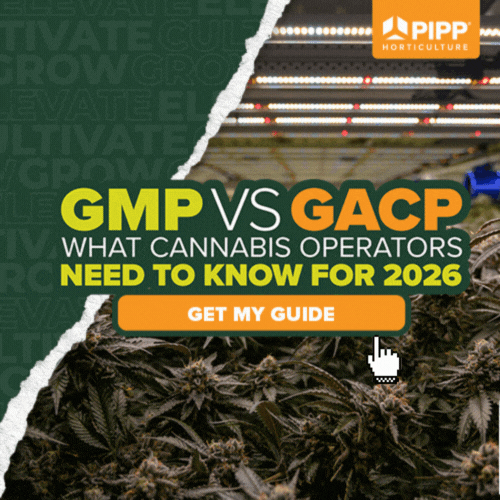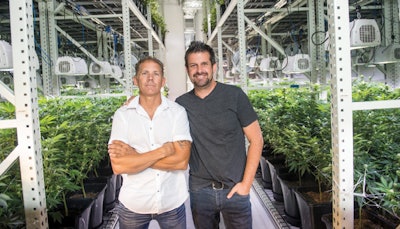
In Sin City (Las Vegas), The Grove stands out. And it’s not just because the previously medical-only marijuana business can now, thanks to a judicial ruling, sell recreational cannabis; it’s because The Grove is a 40,000-square-foot facility smack in the center of the city, with three 1,600-square-foot grow rooms and another three of the same size underway. With a vertical grow system, all-LED lights, and not a single drop of H2O wasted, The Grove is a technologically savvy operation set to double in size in two years.
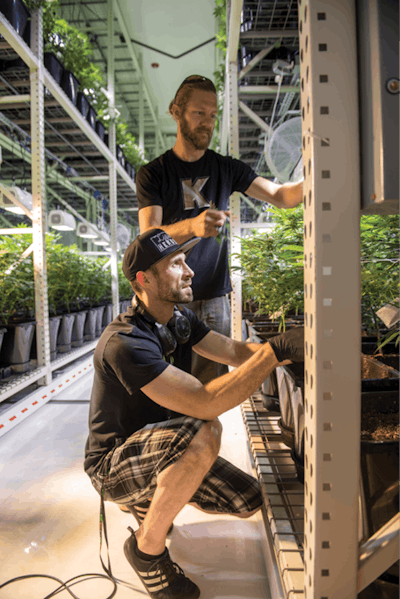
“We’re only half built out currently,” says CEO Demetri Kouretas. “We have another three grow rooms to build out. We [also] hope to apply for as many licenses … as possible. We want to be a big player and have a big footprint in the state of Nevada.”
Here, Kouretas and The Grove Director of Cultivation Kevin Biernacki speak with Cannabis Business Times about their facility and operations, from the biologicals they use in their living soil to their AutoPot and lighting systems—and how they expect Nevada’s new recreational market will change their business for the better.
Jillian Kramer: Where does the name “The Grove” come from?
Demetri Kouretas: We wanted something that could mean many different things. We didn’t want to [pigeonhole] ourselves ..., we wanted to be—not, say, a generic name—but more of something that could encompass a lot of the industry and could mean more than one thing. [With] The Grove, I would think more of harvest, farmer’s market, that kind of feeling—a more natural, more organic feeling.
Kramer: Can you tell us about your movable racks in your vertical grow system?
Kevin Biernacki: … All of our rooms are sealed. We made sure that even drawers have drop seals on them, all the doors, everything, so we have zero light, zero contamination issues. When you come into the rooms, there are eight vertical racks. We have a two-tiered system, we have plants on the bottom tier and plants on the top tier—that are about 9 feet above the bottom tier—so that allows us to be space-efficient. With double the storage, we can double up on the plants. We have approximately 1,400 plants per room, and 160 lights per room.
Kramer: Can you tell us why you chose to utilize all LED lights?
Biernacki: Our main goal here was to be carbon-friendly and as efficient as possible … especially being in Las Vegas, we regularly get summer temperatures up into 115 degrees [Fahrenheit]. … And we wanted to go all LED [lights] so we could save the power costs both on the front-end of running actually 600-watt versus 1,000-watt high lights, but also on the HVAC side. So, the way we had it originally designed, we had 90 tons of AC spread out for each room. But once we decided to go all LED, and we calculated for LEDs, we cut that HVAC cost in half, down to 45 tons of HVAC—so that saves us a huge amount in air conditioning costs.
Kouretas: We kind of took a chance. I would say we were six months—maybe even a year—ahead of most people when it came to going all in on LED lights. There’s always been racks. There’s always been moving racks. There have always been LED lights. But what we did was maximize all these things and kind of went with our theme of being on the technological edge, and that’s what we’ve gone for and what we will continue to do—push the envelope a little bit and be a little different.
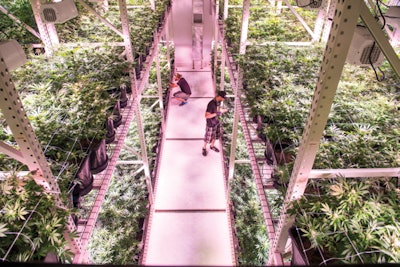
Kramer: Describe your AutoPot system: How does this work, and have you calculated how much time and labor this saves?
Biernacki: The AutoPot system has a float valve inside the base of the pot that allows water to fill up at the base by about an inch or so. And then, when the plant drinks that water down to its base level, it refills itself. So the plant always has the water that it needs, and it drinks when it wants, as opposed to having a person giving it what they think it wants. It’s … a more accurate system that allows the plant to regulate itself.
We definitely have saved. I haven’t done a really accurate count of the labor cost versus hand-watering, because we’ve never really gone through the hand-watering phase. But I can tell you we run the entire cultivation facility [actual grow rooms] with nine employees, and more than 5,000 plants in the building at any given time. So, it’s a very efficient system that allows us not to have anyone hand-watering, because basically everything is watered on its own.
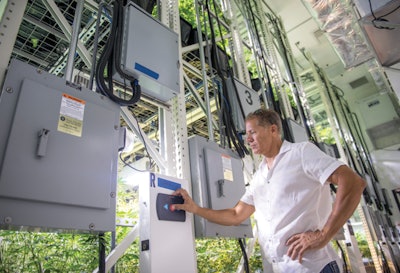
Kramer: What types of lean principles do you utilize so that you maintain a cultivation staff of only nine people?
Biernacki: The way we operate currently … we have three employees in each room, and that’s their room, so that they don’t cross contaminate. So they basically run that whole room from 9 [a.m.] to 5 [p.m.]. And that also gives them a little bit of creativity and leeway to do the things they want to do and experiment slightly. We do a lot of experimenting, actually, because of the LEDs—we’re always trying to learn new ways to do stuff. It gives them responsibility that allows them to have a little bit of pride in their room. And then basically we work it that way so that it stays easy. Three guys can handle those rooms pretty simply. And then the rest of the facility is production and packaging, so we have more employees in those areas.
Kramer: Do you have a favorite experiment that’s come out of these rooms?
Biernacki: Because we have LED lights that are programmable, we can actually adjust the entire spectrum through the reds and the blues and the whites … so that allows us to do a lot of experimentation with lighting. We run Heliospectra lights, and we are kind of a test facility for Heliospectra. One thing we’ve done is just run straight blue lights—no other color but blue—for the last three days before harvest, and we’ve noticed terpene profiles being accelerated. So those are the types of things we like to do. We would like to learn more about the LED lights and how they function, because … there aren’t a lot of people experimenting. There are a lot of lights out there, but there is just not a lot of knowledge about what these different spectrums can do to a plant. And so that’s one of the things we’ve been doing.
Kramer: How are your irrigation and trimming systems automated?
Biernacki: The irrigation is all automated because of [our] AutoPot system. The water [that] comes into the AutoPot is … plumbed in, so there is no maintenance on the irrigation side. On the trimming side, we use a hybrid form of trimming. We do a rough, wet [machine] trim right when we cut, which basically allows us to save a lot of space on hanging plants. Then we can put them on baker’s racks to dry, which allows us to fill a room with a lot more product, because we can have a smaller surface space to dry more product. Then once the product is dry, we hand trim … them, so that they are kind of a hybrid between machine-trimmed and hand-trimmed, so that we get a final product that looks and is every bit as good as a hand-trimmed product right from the start.
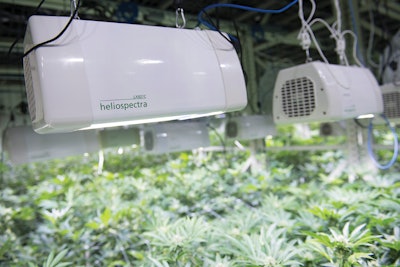
Kramer: What does your Integrated Pest Management program look like? What about your sanitation protocols?
Biernacki: We start inoculating plants with beneficial insects all the way from the very beginning of clone stage. So we will introduce nematodes, we will introduce predator mites, we use soil mites that go into the soil and hunt down any pests that might be a problem. And we do that … through the entire [process]. We have a pretty regimented process, where we hit them from the time they are clones and then we hit them again in bed, and … again when they go into flower and … again mid-flower.. We’re pretty consistent on keeping beneficial insects in place, and that allows us to not have to use any pesticides whatsoever.
And our environment is very precisely controlled. We have enough HVAC and enough air flow … and of course because of the AutoPot, having no … water out in the open—we can control our humidity really finely, and we can reduce any of our microbial issues.
Once everything is cut down, all pots and all bases are removed and washed. Everything is cleaned, and the room is sanitized with Virkon and bleach, and we scrub down the whole room before replanting it.
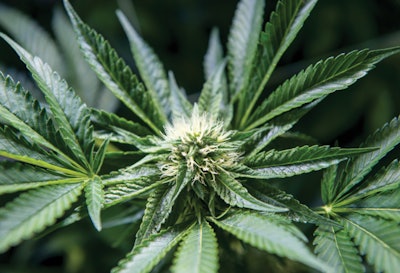
Kramer: It’s been about a week [at interview time] since early recreational sales began in the state. How has production changed as you’ve prepped for the adult-use market? What has the ramp up been like?
Biernacki: It was pretty hectic going into it. There was a lot of drama starting off with the whole alcohol industry wanting to do deliveries—they kind of put a lot of stress on a lot of the dispensaries. So, at that very time right before [July 1], everybody started stockpiling their dispensaries, because everything that was in your dispensary could be sold, and if it wasn’t in your dispensary, you couldn’t deliver it until the alcohol thing gets squared away. So everyone basically just filtered everything they had—all their products—to the dispensaries. We had just stacks and stacks and stacks of stuff at the dispensary. We moved every bit of product out of the building into the dispensary, but I think we are going to benefit from it. I think when we moved product in the dispensaries, we were already sitting on 100 pounds in the dispensary, and we moved about another 200 [pounds] in.
Nevada has gone pretty much like Colorado. We saw over 1,000 patients on [July 1], and there have been lines ever since. We haven’t seen a line that wasn’t out the door yet. We did a huge hiring for the dispensary, right before this happened, so we could have everyone up and trained. We hired almost 100 employees, just because we knew this was going to be a stressful time.
Kramer: What’s the most exciting part of the recreational market, and what’s the most intimidating?
Kouretas: Intimidating is keeping up with product—being able to produce enough product to always have product in the stores and have a variety in the stores. That’s probably the biggest thing. Even though we produce a lot of our own product, we still buy third-party as well just to make sure that we have good variety and good stock, so I think that will be the most intimidating factor—for everybody—just trying to keep up with it. The good part of it is that we have to keep up with it—that we have enough of a customer base that it’s not just sitting on the shelf.

